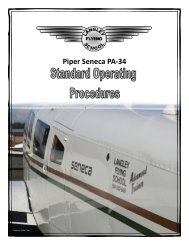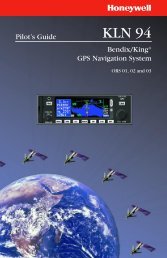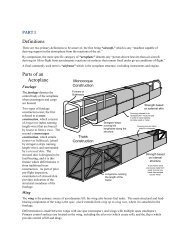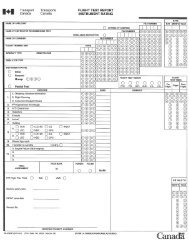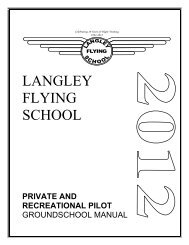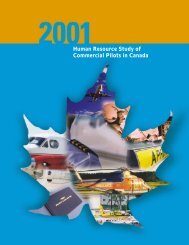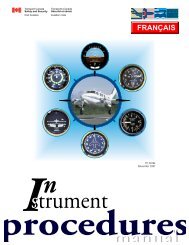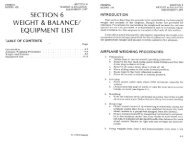LANGLEY FLYING SCHOOL Flight Training Handbook
LANGLEY FLYING SCHOOL Flight Training Handbook
LANGLEY FLYING SCHOOL Flight Training Handbook
You also want an ePaper? Increase the reach of your titles
YUMPU automatically turns print PDFs into web optimized ePapers that Google loves.
<strong>Flight</strong> <strong>Training</strong> <strong>Handbook</strong> Page 38<br />
Langley Flying School, Inc.<br />
assignments.<br />
ETIQUETTE FOR THE PILOT<br />
1. Do not start your engine before being assured your propeller is clear.<br />
2. Do not start your engine with the aeroplane tail pointing toward an open hangar, open window, or closely<br />
parked aeroplanes.<br />
3. Do not start your engine while people are standing in front of or behind your aeroplane.<br />
4. Do not blast your engine while taxiing in close proximity to parked aeroplanes.<br />
5. Do not conduct a long pre-flight run-up while in the vicinity of offices or occupied buildings.<br />
6. Always obtain a briefing from FSS regarding weather and NOTAMs prior to departure.<br />
7. Avoid filing a flight plan by radio right after takeoff if you could have done it by telephone before<br />
departure.<br />
8. Always shut off your engine before loading or debarking passengers.<br />
9. Always warn passengers to keep away from the propeller and not to touch it for any reason.<br />
10. Always taxi at a speed whereby you can come to an immediate stop at any time.<br />
11. In close quarters always taxi with someone at each wing tip for guidance.<br />
12. Always turn off your landing light when holding short of the active runway for departure.<br />
13. Always turn on your strobe or beacon lights when taxiing on an active runway or crossing an inactive<br />
runway.<br />
14. Always leave the controls locked after parking an aeroplane.<br />
15. Always tie down an aeroplane for overnight parking.<br />
FLIGHT INFORMATION CENTRE PRE-FLIGHT BRIEFINGS<br />
The Kamloops <strong>Flight</strong> Information Centre (Kamloops FIC) is the local office of NavCanada agency that provides<br />
flight planning and flight information services to Canadian pilots, including aviation weather and flight-operation<br />
notifications—NOTAMS (Notices to Airman). Prior to each flight, students are required to get a “briefing” from the<br />
FIC’s <strong>Flight</strong> Service Specialists, who can be accessed on the toll-free number 1-866-WX BRIEF. When a “briefing”<br />
is requested, the <strong>Flight</strong> Service Specialist will know exactly what information will be important for you. For them to<br />
do their job, however, you must first tell them the time of your flight, the type of flight you will be doing, and the<br />
location of your flight. Simply say to them “I’m Joe Blow, a student at Langley Flying School, and I will be<br />
departing in a half-hour for a training flight within 20 nautical miles of Langley Airport . . the flight will last about<br />
an hour . . could I please have a briefing . .” The FSS Specialist will then give you all the information you need<br />
(the request for a “briefing” is the key), including NOTAMs and AIRMETs.<br />
Aviation weather data is available to students on NavCanada’s website www.flightplanning.navcanada.ca, and when<br />
possible, students should review information here prior to contacting the <strong>Flight</strong> Service Specialist. Remember too<br />
that this briefing can be done at home or in the office prior to coming to the School for a scheduled training flight.<br />
With respect to weather information, the Terminal Aerodrome Forecast (TAF) for Abbotsford Airport is the most<br />
detailed forecast information we can get for the closest location to Langley Airport—a terminal forecast for Langley<br />
Airport is not published. The next nearest TAF would be for Vancouver Airport, but owing to its coastal location,<br />
often experiences different weather from us. If your training flight takes you away from Langley Airport, you must,<br />
of course, get appropriate weather forecasts for the planned route.<br />
NOTAMs provide information related to any changes—temporary or permanent—that is not contained in existing<br />
2012 David L. Parry



